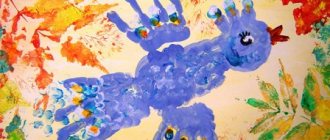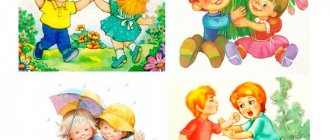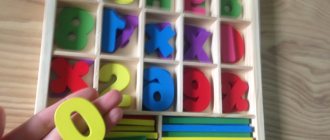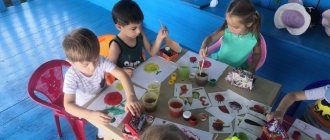Project "Color Week"
Organization of project activities.
1.GCD.
“Journey to a red fairy tale”, “Journey to a yellow fairy tale”, “Journey to a blue fairy tale”, “Journey to a green fairy tale”, “Journey to a multi-colored fairy tale”
Target:
Formation of ideas about color. Expand children's understanding of the variety of colors. Teach children to use an adjective (red, blue, etc.) in speech and correctly agree it with a noun.
2. Observing colored objects
Target:
To consolidate and systematize children's knowledge about primary colors.
3. Conversations:
“What happens to be red?”, “What happens if there is no red color?”. “The nature of color and the color of nature”, “Where you can find water.” “What is indicated in blue on the globe?”
4. Play activities. Card index of outdoor, didactic, finger games:
1. Verbal games and exercises: “The fourth odd one”, “Find and name everything blue”, “Let’s get to know each other - I’m Blue, Blue”, “Let’s get to know each other - I’m Green”, “Find and name everything green”
Breathing exercises: “Green Ball”
Target:
develop speech breathing, develop the ability to exhale smoothly and for a long time.
Target
: develop auditory attention; cultivate endurance; learn to compose a descriptive story, develop attention, coherent speech; find similarities and differences; develop children's independence in play.
2. Finger games: “Rainbow-arc”, “Blue puddles of spring” finger gymnastics “Tree”
Target
: to develop the ability to coordinate movements with speech, develop fine motor skills of the fingers, and form an idea of color.
3. Outdoor games: “Multi-colored carousel”, “For the blue one”, “Walk along the blue path, you will find blue boots.”
Target
: develop the ability to run quickly without bumping into each other.
“Multi-colored balls”, train the child to throw a ball into the distance with both hands.
4. Constructive game “Yellow Town”
Target:
consolidate the skill of building buildings from bricks, cubes, plates of different sizes and colors, develop the ability to communicate and help in the process of playing with buildings, promote the assimilation of words-names to designate building parts.
5. Creative play with toys.
Didactic games:
“Let’s collect bouquets for the Dwarfs”, “Fold a pattern”, “Colored houses”, “Colorful cleaning”
Target
: consolidate the ability to group objects by color.
6. Artistic and speech activity.
Reading of the poem “A Multi-Colored Gift” by Pyotr Sinyavsky.
Guessing “colorful” riddles;
Reading the story “A Multi-Colored Tale” by S. Ya. Marshak; “Letter from Dunno”, “A Tale of Colors”.
Target
: to form in children the concept of color, to cultivate love and respect for their native nature, to teach them to listen carefully, to develop speech and memory. To consolidate children's knowledge about color through reading fiction and memorizing poetry.
Didactic games “Days of the week” in the senior group
We present games for 5-6 year olds. Preschoolers learn to name the days in the correct order. With the help of games, they develop an idea of the names of days, time terms, the basic palette, and the skill of ordinal and quantitative counting.
Didactic game “Live Week”
To play, prepare cards with numbers from 1 to 7 and an upbeat musical composition. There are two game options:
- Give cards to students. Turn on music that the children run and dance to. As soon as the music stops, players must line up in the order corresponding to the week. Each child in the row names their day. Next, the children exchange cards and the game continues.
- Divide the students into groups, each with 7 people. Designate a table for each group. Place the cards on the tables so that the numbers shown face down. Each card has its own color. Turn on the music to which the players run and dance. When the music stops, the children run up to their tables, grab a card, see what number they got, and line up accordingly.
Magic flower
To play, cut out a cardboard flower with 7 petals. Each petal has its own color, corresponding to the rainbow palette. Show the flower to the students, tell them that it is magical, because only magical flowers have all the petals of different colors. Ask students to count how many petals there are. When the children answer “seven,” ask them to remember what else happens in such quantity. If the players are at a loss, hint to them that the rainbow has 7 colors and there are 7 days in a week.
Next, the game is built step by step:
- Ask the children to name the days of the week in the correct order. At the same time, point your finger at the petals one by one.
- Bend one of the petals without the players noticing. Children must figure out which color has disappeared and name the corresponding day of the week.
- Point to the petals and ask them to name the neighboring ones. For example, when pointing to “Tuesday” and asking “and tomorrow...” children should answer “Wednesday.” Or: “Friday, and yesterday... Thursday.”
Gnomes
For the game, prepare images of 7 funny gnomes; their caps should be rainbow-colored and close to a certain geometric shape: triangle, circle, square, rectangle, oval, hexagon, trapezoid. Also make from cardboard 7 geometric shapes corresponding to the caps and an image of a house with 7 doors in rainbow colors.
The game is played in 4 variants:
- Line up the gnomes. Call them the days of the week. When the students close their eyes, hide one figurine. Opening their eyes, the children say which day disappeared.
- When the players close their eyes, switch the gnomes' places. Having opened their eyes, children place the figures in the correct order.
- Place geometric shapes in front of the children. Ask to choose a figure suitable in shape and color for each gnome cap.
- Show the players a picture of a fairytale house. Ask them to name which door each gnome should go through.
Fun week
To play, make a circle out of cardboard and divide it diagonally into 7 parts. Color each part in a different color of the rainbow and write the corresponding number. Also cut out two images of bees: one is working, flying with nectar, the second folded its wings to rest. Attach magnets to the back of the bees and the week circle.
The game lasts a week. Every day, when children come to kindergarten, they move the bees to the appropriate day. Moreover, a working bee must be shifted only on weekdays, a resting bee - on weekends. The goal of the game is to form in preschoolers an idea of working days and weekends.
How to teach a child the months of the year?
Everyone has their own pace of assimilation of information, but on average, a five-year-old child is already quite ready to learn the months, correctly pronounce names and remember sequences.
- Pick up educational cartoons about the seasons - this will help you spend your time in front of the screen.
In our opinion, the series “Seasons with Auntie Owl” is very successful. Aunt Owl's lessons in a simple and accessible form will quickly and easily teach your child to distinguish between the seasons. About every month in the cartoons there is a poem, information about the weather, what kind of life different animals lead at this time and what changes occur in plants. Aunt Owl talks about different types of recreation and entertainment that are popular in a particular month, and introduces useful signs that help predict the weather.
After watching the lessons, your child will easily remember the sequence of months of the year and get an idea of various natural phenomena and their causes.
- Developmental benefits for the seasons and months.
Nowadays you can find many interesting books and ready-made teaching aids for children; they will help your child remember the sequence of seasons and months.
blogspot.com
You can make educational aids and games yourself.
www.maam.ru
kindergarten-kitty.ru
- Coloring pages.
Thematic coloring pages will help you learn the correct sequence of months of the year and remember which months belong to which season and in what order they replace each other. By drawing, the baby will train motor skills and hand-eye coordination. The colors chosen for each season will help create a visual image and make it easier to remember the months.
You can download coloring pages by month for free HERE.
- Calendar.
Another very effective way to easily remember the names of the months is to make your own calendar. On a piece of paper, draw a grid corresponding to the number of days in the current month. Together with your child, note what events you have planned for what dates this month. For example, it’s someone’s birthday, on some day you and your whole family go to the cinema or to a children’s event, etc. If the baby already knows how to write independently, let him number the days himself; if not, help him do this. Offer to draw a thematic picture reflecting what is happening in nature this month.
Gradually you will make a calendar for all 12 months. The baby will be proud and happy! Thanks to this task, the child will broaden his horizons, develop counting and fine motor skills, and remember the months faster.
Playing with colors
Thematic week: “Playing with colors.”
Introduction.
Why do children draw? This is one of the ways to improve the body. Early in life, drawing develops vision and the ability to see. The child learns the concept of “vertical”
and
“horizontal”
, hence the linearity of early children's drawings.
Then he comprehends the forms of materials and gradually comprehends his surroundings. This happens faster than the accumulation of words and associations, and drawing makes it possible to express in figurative form what
the baby has already learned and what he cannot always express verbally. Drawing helps a child organize rapidly acquired knowledge and increasingly complex ideas about the world. Why, as children grow up, do they stop drawing? It’s because the word becomes more important.
Idea:
Creating ideal conditions, a favorable emotional microclimate for the creative, intellectual process in which preschoolers have the opportunity to discover and develop creative personal potential, improve consciousness and emotional saturation in the process of child-adult interaction.
Relevance of the topic:
An analysis of the requirements of the Federal State Educational Standard shows the need to build the educational process on the basis of a complex thematic principle close to the so-called “event-based”
principle, which will make the life of children in kindergarten more interesting and the educational process more motivated. Because a child, as we know, is able to assimilate an educational program compiled for him by adults only if it becomes his own program, that is, if it becomes interesting and meaningful for him.
Estimated distribution of roles in the group:
Educators:
organize educational situations, joint productive activities, and counseling parents.
Children:
participate in educational and play activities.
Parents:
prepare material for teaching children, consolidate the knowledge acquired by children in practice.
Each day of the week corresponds to a specific color. To raise the emotional mood, each of the children is invited to dress in the color of the day and bring an object or toy of this color to the kindergarten, and the kindergarten premises are decorated with balloons of the corresponding color. The activities of children in the group are also subject to a certain color.
Target:
Fixing all colors and the ability to find objects of a given color around you. Reinforce knowledge of the days of the week
and their sequence.
Tasks:
• To consolidate knowledge of the color spectrum in children.
• Teach children to draw a rainbow and name its colors correctly.
• Learn to distinguish colors, compare them with objects
Preparatory group
For preschoolers aged 6-7 years, more complex educational games are provided that develop logic and thinking abilities.
Hide and seek
Tell the students that the days of the week wanted to play hide and seek. But there is a hint that allows you to quickly find them. Each of them hid behind an object or in a room whose name begins with the same letter as the day. Name this object, and the children must guess the day.
For example:
- hid behind the desk... Monday;
- behind the hanger... Tuesday;
- behind the bench... Wednesday;
- in the attic... Thursday;
- in the hallway... Friday;
- behind the chair... Saturday;
- in the bathroom... Sunday.
Say the word
To play you need a ball. Throw it to the players one by one, asking questions like this:
- on Monday mom works, and on Sunday... she rests;
- Wednesday is followed by... Thursday;
- Tuesday is today, and Wednesday is... tomorrow;
- Today is Friday, and yesterday was... Thursday.





